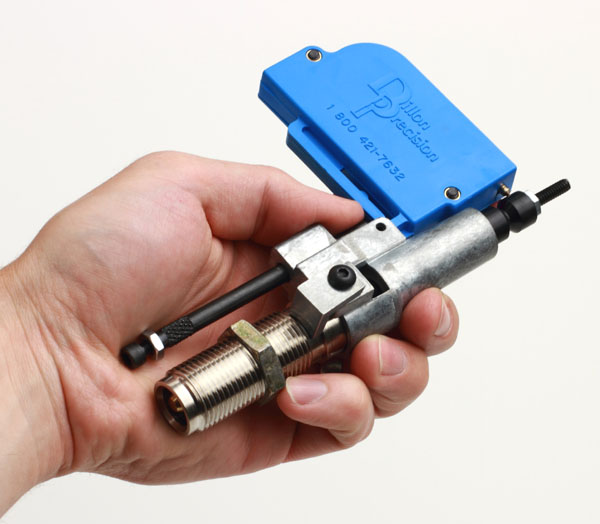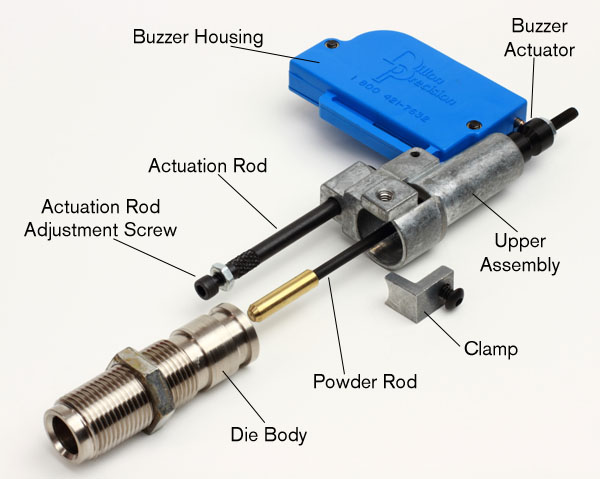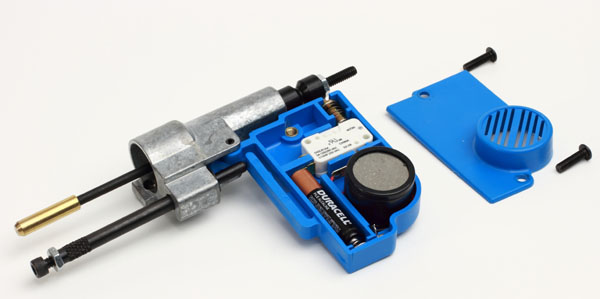Recently, I’ve been writing about reloading safety. This is perhaps the most important thing to incorporate into your reloading workflow! In my last post, I gave a high-level view and comparison of the various popular powder check systems that are on the market today. There are really quite a few options that are tailored to different price points, applications, and specific equipment.
Dillon is known for their comprehensive accessories for the reloading presses they manufacture. The components and parts are really designed as a proper “system”. They’ve also made sure that all aspects of operating a clean, tidy, efficient, and safe reloading room are covered by their product offerings. One such product is the Dillon Powder Check System (Dillon Part #21044). This system is designed specifically for the Dillon XL-650 (5 station) and Dillon Super 1050 (7 station) progressive reloading presses.
Before we deep-dive on specifics, let’s take and overview look at the various components of this powder check system.
**Note that this article is specific to the XL-650, and some of the descriptions do not apply to the Dillon Super 1050 press which operates in a different manner. This powder check system operates in a consistent way on both presses but some operational details differ.
The complete assembly:

You can see that this is a massive unit!
Here are the individual components that make up the assembly:

Now that you have “seen” the powder check assembly, let’s cover the purpose of each component:
Die Body
The die body is the same unit that is used with the powder measure. It screws into the press toolhead and allows the powder check assembly to be swapped from one toolhead easily.
Upper Assembly
The upper assembly is the main portion of the powder check system. This is the component that essentially holds everything together.
Clamp
The clamp is the same type as used on the powder measure system. You back out an allen screw, and that allows the upper assembly to be removed from the die body.
Powder Rod
The powder rod has a brass tip on it that actually contacts the powder to raise and lower the rod to the proper position.
Buzzer Actuator
The buzzer actuator will cause the buzzer to sound if the ram is at the top of the stroke and the powder level is not correct. When the powder level is correct, the groove in the buzzer actuator prevents the brass pin from depressing, therefore preventing the buzzer from sounding.
Buzzer Housing
The buzzer housing pivots every time the ram reaches the top of its stroke. This housing contains the buzzer, a AAA battery, and the switch/contact which interfaces with the buzzer actuator.

Actuation Rod and Adjustment Screw
The actuation rod is what contacts the ram (the shellplate carrier) each time the ram reaches the top of its stroke. The actuation rod is adjustable so that the proper contact clearances are attained between the buzzer switch contact (brass point) on the buzzer housing and the buzzer actuator on the powder rod.
I think it’s really easiest to explain how this powder check system works by watching a video!
Here’s the powder check system in action on the Dillon XL-650 (older video):
I think that pretty much covers the basics of the Dillon Powder Check System. One of the things I like about this system is the fact that you can always “hear” what’s going on, but this system does not lock up the press when you have slight variations in powder level. Overall, it’s a great system. It’s too bad you can’t use it on other presses (unless you modify the press). Guess what? Batteries (one at least…) *are* included with this product!
Stay tuned for more powder check system posts…
Thanks,
Gavin


















































































Hi, this response is not to the Dillon Powder Check but about your Press Pedestal. What are the height and base plate dimensions. I would like to have one welded up for my Rock Chucker?
Great channel I just stumbled across it yesterday, so if your downloads go up it is me!
Happy Labour Day. Canadian spelling Cheer
Bert
Hi, great job on the Dillon powder check die. Do you think it can be installed on a Hornady progressive? Provided a drill a hole for the actuator rod? I just like the Dillon system, been struggling with the RCBS lock out die. Thanks
Why in the world would you want something on the press to lock it up? The buzzer just went off and you can’t fix anything until the ram is back down. You know the case at the bullet set is over or under and also the next one to go up in the powder check. Pull them two and dump the powder back in the hopper and run them through at the end of the string after making your adjustments.
I have run a 650XL for years with four different powder hoppers and have never found them to vary more than +/- 0.1gr.
You have a great site here and I for want to tip my hat to you and say thanks…
Best, Baldy
QUESTIONS: Why in the world would you want something on the press to lock it up?
ANSWER: Because you get used to the alarm going off inappropriately and it isn’t a “fail-safe” system. If the press stops, you can’t keep going. It depends on how highly you value you “eyeballs” and “fingers”. A “she’ll be right” attitude like that might be ok for you, but I would rather stab myself in the leg, than get a squib load or double charge. (Yeah, but what are the odds of that happening? I hear you say. Well…go ask Brandon Lee! – Oh yeah, he’s DEAD!!!!
Nice place you have here. I enjoy every bit of it. Thanks. Bob.
Re: Hornady Pogressive and the Dillon Powder Check
Yes, it can be installed and works great but requires 1 of 2 modifications. A google search for the topic (I believe at a glock forum) will show pictures of both, which is how I found it.
1) Cutting or grinding a groove into the side of the top portion of the hornady press to allow the rod in the powdercheck to fall straight vertically downward. A modification of the washer is also needed. I took this approach. Got red paint that matches real well to cover the groove. The check works fantastic. I have no idea what this does to any warranty. But if Hornady ever refused to do something to my press unrelated to that groove, then I will get a Dillon.
2) Another approach was to rig a bent rod, U shaped, to go around the top part of the body. This looks awful, but it works. There might be a video of this one on you tube. I cannot recall.
Very nice. I am curious, though, how exact or ‘sensitive’ is this checker to the amount of gunpowder dialed in. IE: how much of a reduction of a ‘proper’ load is needed to cause the buzzer to sound? .1 grain or 2 grains… or?
Thanks a ton!
~R
Ah, one other thought… I am using Trail Boss for my cowboy reloading… is there any chance that the brass powder Rod could negatively compact or compress the powder?
Again, thanks for your thoughts.
~R
Any ideas on how to keep powder from sticking to the plunger on the powder check system? I tried it several times and it seems to catch a few grains with each pull.
Thanks!
Clean the plunger with automotive brake cleaner & allow to dry. then, dip it in fine graphite powder or fine crushed mica. It’s similar to flouring a cake pan, powder no longer sticks to it and neither product will contaminate the powder charge or cause any problems in the reloading process. I use this on my powder measure as well.
Dillion tech support informed me to clean the brass plug to the rod with rubbing alcohol and apply car wax. They also mentioned not to lube my pistol cases.
I have this installed on my 650, and I have run into a curious problem. Every 150 rounds or so, the die slowly starts to buzz. and after about round 175 it clearly buzzes on each pull. I have checked every 10th case as well as early buzz and full on buzz and my dillon powder measure is rock solid slinging 4.9 grain charges.
I believe the device is activating for what it believes to be an undercharge as i have to screw the rod back up a few turns to “rezero” it for another 150 rounds. Has anybody had this problem?
I had the same problem.
Make sure you have the extra counter nut in place, and make it tight once dialed in
I found the high pitched buzzer impossible to hear. (I’m 70 y.o. and very hard of hearing.) I turned the buzzer mechanism around, after drilling a 1″ hole in the case. You have to grind a small ear off of the buzzer. I also had a friend wire in a 1.5 volt bulb. Works pretty good.
I wish Dillon had offered a different frequency buzzer- similar to but different from the low primer buzzer.
I bet I’m not the only reloader to run across this problem.
Semper fi,
Howard
Dan -some times case lube is add too much sticky and builds up and causes the Piston/Plunger to stick. It could come from the rim of the cases. An Honorable result of a Good Re-loader, clean and go. I am working on a Design that should be cheaper, But a Back surgury has put me down for awhile
I reload 10 Different Pistol and rifle Makes combined. It is Unfortunate. I cannot get all the setups through dillon. parts are backordered. and Have been Back ordered for a while now. Do not buy a System unless you can get the accessories. I would have kept my RCBS. and i miss my Rockchuker pres for the Swageing and Depriming Jobs. keep that Old reliable for those Jobs. Just a Helpfull Note.
well i had no problem getting anything from dillon untill the new obama gub control push. they always had items in stock. its not dillon, its everyone buying every thing they can get there hands on. try finding 22 or .223 ammo dies ect. or reloading components of any kind now. or guns for that matter.
so saying Do not buy a System unless you can get the accessories doesnt hold any truth in the current political climate we are in now.
I have found a solution to the high pitched buzzer problem with the help of Steve Thone (dillonupgrades.com)
I replaced the powder sensor buzzer with this:
“Buzzer w/leads 1.5 volts” by American Scientific on Amazon. It sounds a lot like the original low primer buzzer. BTW, the new low primer buzzer is very high pitched; I replaced it as well.
Howard W. Evers
Regarding my comment above, about the high pitched buzzer:
With the help of Steve Thone (dillonupgrades.com –nifty stuff!) I was able to purchase a suitable replacement buzzer on Amazon.com:”buzzer w/leads 1.5 volts, by American Scientific-$5.75″
THEN: Just after I installed this new buzzer, my low primer buzzer failed. Dillon replaced, of course. BUT: the newer units now come w/a high pitched buzzer. So this was replaced as well.
Hope this helps.
Howard